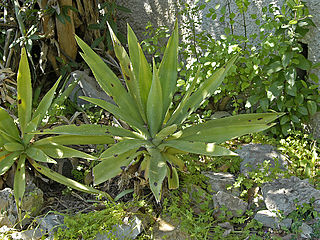
Salix fragilis, with the common names crack willow and brittle willow, is a species of willow native to Europe and Western Asia. It is native to riparian habitats, usually found growing beside rivers and streams, and in marshes and water meadow channels.

Stereospermum is a genus of trees in the paleotropical clade of the family Bignoniaceae. A species of Stereospermum is used in herbal medicine in Ayurveda as well as it is an integral part of the culture and tradition of the cold desert biosphere reserve.

Colubrina is a genus of about 30 species of flowering plants in the family Rhamnaceae, native to warm temperate to tropical regions of Africa, the Americas, southern Asia, northern Australia, and the Indian Ocean islands. Common names include nakedwood, snakewood, greenheart and hogplum. The generic name is derived from the Latin word coluber, meaning "snake", and refers to the snake-like stems or stamens.

Alangium is a small genus of flowering plants. The genus is included either in a broad view of the dogwood family Cornaceae, or as the sole member of its own family Alangiaceae. Alangium has about 40 species, but some of the species boundaries are not entirely clear. The type species for Alangium is Alangium decapetalum, which is now treated as a subspecies of Alangium salviifolium. All of the species are shrubs or small trees, except the liana Alangium kwangsiense. A. chinense, A. platanifolium, and A. salviifolium are known in cultivation.
René Paul Raymond Capuron was a French botanist. Capuron was responsible for an extensive amount of work on the tree flora of Madagascar. Several tree taxa with the specific epithet of capuronii honor his name, examples being Podocarpus capuronii and Schizolaena capuronii.

Dialium is a genus of legume in the family Fabaceae, subfamily Dialioideae. Velvet tamarind is a common name for several species.
Camptolepis is a genus of plant in family Sapindaceae. It contains the following species :

Erythrophysa is a genus of plant in the family Sapindaceae. It contains the following species :

Kirkia is a genus of plant in family Kirkiaceae. It was previously placed in family Simaroubaceae, but was transferred into Kirkiaceae, together with Pleiokirkia, because these genera produce neither quassinoids nor limonoids.
Mahonia decipiens is a species of shrub in the Berberidaceae described as a species in 1913. It is endemic to Hubei Province in China.

Poupartia is a genus of plant in family Anacardiaceae.

Horagolla National Park is one of the latest national parks in Sri Lanka. It is so called because of an abundance of Dipterocarpus zeylanicus (hora) trees. The area was originally declared as a wildlife sanctuary on 5 September 1973 due to its rich biodiversity. Later on 24 June 2004, Horagolla was elevated to national park status. Horagolla is the only urban park in the Western Province of Sri Lanka. The park is situated close to Horagolla Walauwa, the home of the Bandaranaike family. The park is situated some 40 kilometres (25 mi) from Colombo.
Ludia is a genus of plants in family Salicaceae.
Malagasia is a monotypic genus of trees in the family Proteaceae. The sole species is Malagasia alticola, endemic to Madagascar.

Agave decipiens, common names False Sisal or Florida agave, is a plant species endemic to coastal Florida though cultivated as an ornamental in other regions. The species is reported naturalized in Spain, India, Pakistan, and South Africa.
Doratoxylon is a genus of flowering plants in the family Sapindaceae.
Dialyceras is a genus of trees in the family Sphaerosepalaceae. The species are all endemic to Madagascar.
Rhopalocarpus is a genus of plants in the family Sphaerosepalaceae. Most species are trees and all are endemic to Madagascar. The generic name is from the Greek meaning "club fruit", referring to the fruit shape.

Filicium decipiens, called the ferntree, fern tree or fern leaf tree, is a species of Filicium found in east Africa, Madagascar, India and Sri Lanka. It is planted as an ornamental tree in the Indian subcontinent, Indonesia, Hawaii, and elsewhere.
Fagaropsis is a genus of flowering plants in the rue family (Rutaceae), native to Africa and Madagascar. Its inclusion in the subtribe Toddalioideae is controversial. Trees or shrubs, they are valued for their timber and used in traditional medicine.











